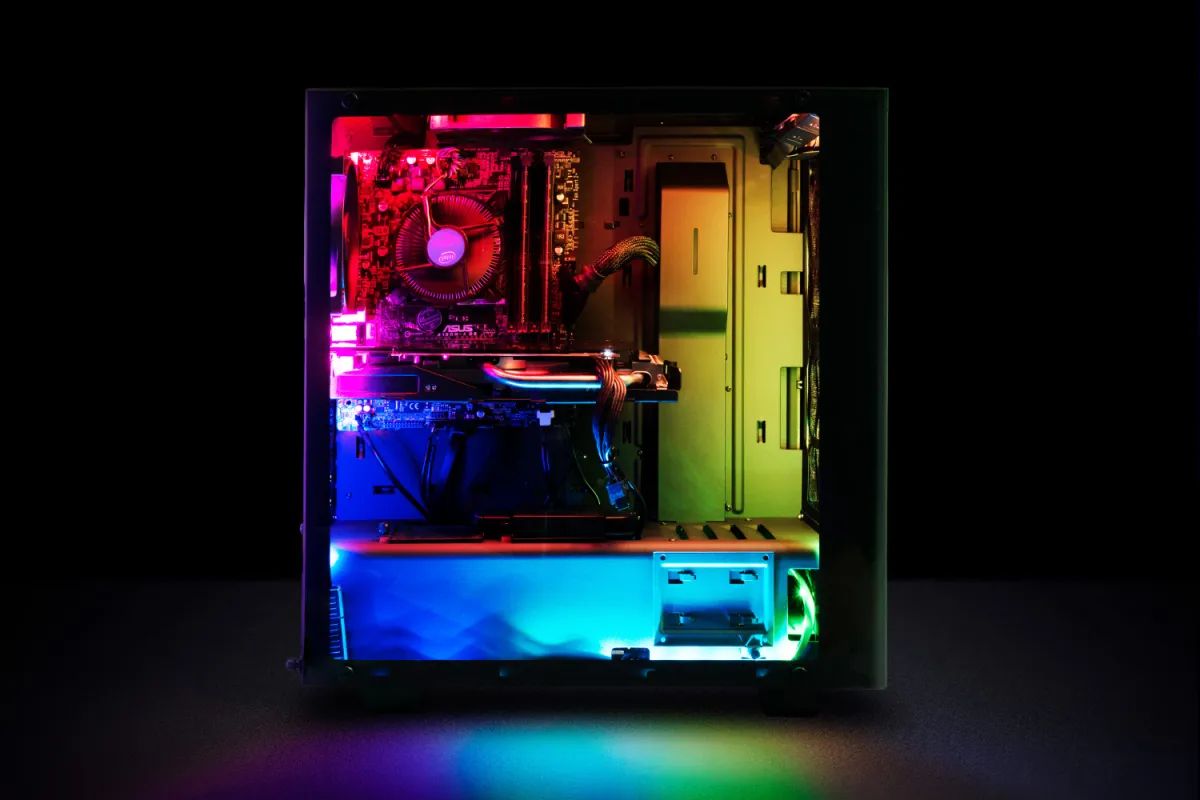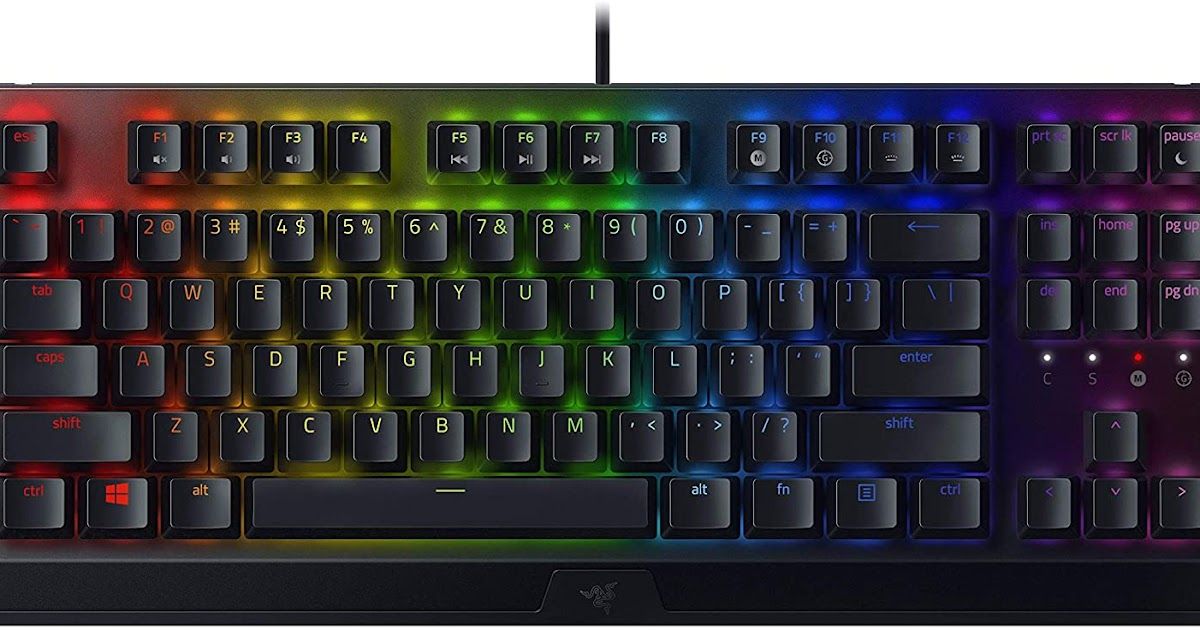Introduction
Adding lights to your PC case can transform it into a stunning visual display that enhances your overall gaming experience. With Razer Synapse, a powerful software tool developed by Razer, you can easily personalize the lighting effects on your Razer peripherals to create a customized gaming setup.
Razer Synapse allows you to unleash your creativity and make your gaming rig truly unique. Whether you want a pulsating rainbow effect, a dynamic wave pattern, or a simple static color, Razer Synapse provides a plethora of customizable lighting options to suit your preferences.
In this guide, we will take you through the step-by-step process of adding lights to your PC case using Razer Synapse. We’ll cover everything from downloading and installing the software to customizing the lighting effects for individual peripherals. By the end of this guide, you’ll have the knowledge and skills to elevate the aesthetics of your gaming setup to new heights.
So, let’s dive into the world of Razer Synapse and learn how to create a visually stunning PC case that will wow your friends and take your gaming experience to the next level.
Requirements
Before you start adding lights to your PC case using Razer Synapse, you’ll need to ensure you have the following:
- A computer with Windows operating system (Razer Synapse is compatible with Windows 7 or higher)
- At least one Razer peripheral that supports Chroma lighting (such as a Razer keyboard, mouse, or headset)
- An internet connection to download and install Razer Synapse software
- A USB port to connect your Razer peripherals to your computer
It’s worth noting that Razer Synapse is specifically designed for Razer products, so you’ll need to ensure you have at least one compatible Razer peripheral to make use of the lighting customization features.
Furthermore, for optimal performance and compatibility, make sure your computer meets the minimum system requirements for Razer Synapse. These requirements may change, so it’s always a good idea to check the official Razer website for the most up-to-date information.
Once you have met these requirements, you are ready to proceed with the process of adding lights to your PC case using Razer Synapse. Don’t worry if you’re new to Razer Synapse or customization software – we’ll guide you through each step to ensure a smooth and successful lighting setup.
Now that you have everything you need, let’s move on to the first step – downloading and installing Razer Synapse.
Step 1: Download and install Razer Synapse
The first step in adding lights to your PC case using Razer Synapse is to download and install the software onto your computer. Here’s how:
- Head over to the official Razer website (https://www.razer.com/synapse) and navigate to the Razer Synapse download page.
- Click on the download button to start downloading the installer file. The file size may vary depending on the version, so it might take a few moments to complete.
- Once the download is finished, locate the installer file in your computer’s Downloads folder or the folder you specified for downloads.
- Double-click on the installer file to launch the installation wizard.
- Follow the on-screen prompts and accept the license agreement to proceed with the installation.
- Choose the installation directory where you want to install Razer Synapse, or leave it as the default location.
- Click on the “Install” button to begin the installation process.
- Wait for the installation to complete, which may take a few minutes.
- Once the installation is finished, you can choose to launch Razer Synapse immediately or do it later manually.
Once Razer Synapse is installed on your computer, you are ready to move on to the next step: connecting your Razer peripherals.
Remember to keep your internet connection active during the installation process, as Razer Synapse will automatically check for any updates and download them if necessary. This ensures you have the latest features and fixes for optimal performance.
Now that you have successfully installed Razer Synapse, let’s move on to step 2: connecting your Razer peripherals.
Step 2: Connect your Razer peripherals
Now that you have Razer Synapse installed on your computer, it’s time to connect your Razer peripherals. Follow these steps to ensure a proper connection:
- Gather your Razer peripherals, such as a Razer keyboard, mouse, or headset.
- Locate the USB cable(s) that came with your Razer peripherals.
- Plug one end of the USB cable into the corresponding port on your Razer peripheral.
- Plug the other end of the USB cable into an available USB port on your computer.
- Repeat this process for each Razer peripheral you want to connect.
- Ensure that the USB connections are secure and firmly plugged in.
Once you have successfully connected your Razer peripherals to your computer, they should be ready to be recognized by Razer Synapse.
Razer Synapse will automatically detect and display your connected Razer peripherals, allowing you to customize their lighting effects. If, for any reason, your peripherals are not recognized, try reconnecting them or restarting your computer.
Now that your Razer peripherals are connected, let’s move on to step 3: opening Razer Synapse and navigating to Chroma Studio.
Step 3: Open Razer Synapse and navigate to Chroma Studio
Now that you have your Razer peripherals connected, it’s time to open Razer Synapse and navigate to the Chroma Studio, where you can customize the lighting effects. Follow these steps:
- Locate the Razer Synapse icon on your desktop or in the Start menu and double-click to launch the software.
- If prompted, sign in to your Razer account or create a new one. This will allow you to synchronize your settings across multiple devices and access additional features.
- Once logged in, you will be taken to the Razer Synapse dashboard. Look for the “Chroma Studio” tab in the top navigation menu and click on it.
- After clicking on the Chroma Studio tab, you will be presented with a variety of lighting customization options. These options may vary depending on the Razer peripherals you have connected.
- Explore the different lighting effects available, such as Spectrum Cycling, Breathing, Reactive, or Custom effects. Click on each effect to preview how it looks on your connected Razer peripherals.
- Take some time to familiarize yourself with the Chroma Studio interface, as it provides you with various tools and options to customize the lighting effects according to your preference.
- Now, you are ready to start customizing the lighting effects for your Razer peripherals. In the next steps, we will guide you through the process of choosing your desired lighting effect and adjusting the settings to create a personalized lighting setup.
By opening Razer Synapse and accessing the Chroma Studio, you have taken the first step towards transforming your gaming setup into a visual masterpiece. Now, let’s move on to step 4 and choose your desired lighting effect.
Step 4: Choose your desired lighting effect
With Razer Synapse and the Chroma Studio now open, it is time to choose the lighting effect that best suits your gaming setup. Follow these steps to select your desired lighting effect:
- In the Chroma Studio interface, you will see a variety of pre-set lighting effects along the left-hand side of the screen. These effects may include Spectrum Cycling, Breathing, Static, Wave, and more.
- Click on each lighting effect to see a preview of how it will appear on your connected Razer peripherals. Take your time to explore the different options and find the one that appeals to you the most.
- If you want to create a completely custom lighting effect, click on the “Custom” option. This will allow you to control individual LEDs on your Razer peripherals and create unique lighting patterns.
- Once you have chosen a lighting effect, you can further customize it by adjusting the settings specific to that effect. For example, you can modify the color, speed, brightness, and direction of the effect to your liking.
- As you make changes to the lighting effect settings, you will see the real-time updates on your connected Razer peripherals in the preview window. This allows you to fine-tune the lighting effect until you achieve the desired look.
- Feel free to experiment with different combinations of lighting effects and settings to create a truly personalized lighting setup. You can always go back and change the effect or settings later, so don’t be afraid to get creative!
Remember that the available lighting effects and customization options may vary depending on the Razer peripherals you have connected. Some peripherals may have more advanced features, allowing for even more intricate and detailed lighting effects.
Now that you have selected your desired lighting effect, it’s time to move on to step 5 and adjust the lighting settings to fine-tune the effect to your liking.
Step 5: Adjust the lighting settings
Now that you have chosen your desired lighting effect, it’s time to adjust the lighting settings to further customize and fine-tune the effect. Follow these steps to make the necessary adjustments:
- Within the Chroma Studio interface, locate the settings panel on the right-hand side of the screen. This is where you can modify various parameters related to the selected lighting effect.
- Depending on the lighting effect you have chosen, you may have different options available to adjust. These options could include color selection, speed control, brightness level, direction, and more.
- If the lighting effect allows for color customization, click on the color swatch or color wheel to choose your preferred color. You can also enter the RGB values or select from a list of preset color options.
- To control the speed of the lighting effect, use the speed slider or numerical input field. Sliding the speed towards the left will make the effect slower, while sliding it towards the right will make it faster.
- If the lighting effect has brightness adjustment, use the brightness slider or input field to make it brighter or dimmer. This allows you to find the perfect balance between vibrant lighting and a more subdued ambiance.
- Some effects may have directional settings, allowing you to choose the direction in which the lighting effect moves across your peripherals. Play around with these settings to achieve the desired visual impact.
- As you make changes to the lighting settings, keep an eye on the preview window to see how the adjustments affect the overall look of the lighting effect on your connected Razer peripherals.
- Feel free to experiment and iterate on the settings until you are satisfied with the result. Don’t be afraid to try different combinations of colors, speeds, and brightness levels to achieve your desired aesthetic.
Remember that the available settings may vary depending on the lighting effect and the specific capabilities of your Razer peripherals. Some peripherals may have additional settings or advanced features that offer even more control over the lighting effects.
Once you have adjusted the lighting settings to your liking, you can move on to step 6 and customize the lighting for individual peripherals, if desired.
Step 6: Customize the lighting for individual peripherals
If you want to take your lighting customization a step further, Razer Synapse allows you to personalize the lighting for each individual peripheral. Follow these steps to customize the lighting effects for your specific Razer peripherals:
- In the Chroma Studio interface, you will see a list of all the connected Razer peripherals on the left-hand side of the screen.
- Click on the name or icon of the peripheral you want to customize. This will bring up the individual settings panel for that specific peripheral.
- In the individual settings panel, you will find options to modify the lighting effect, color, speed, and any other relevant settings specific to that particular peripheral.
- Experiment with different settings and adjustments to create a unique lighting profile for each peripheral. For example, you can assign different colors to different zones on a Razer keyboard or set up a custom lighting effect for your Razer mouse scroll wheel.
- As you customize the lighting for individual peripherals, you can continue to use the preview window to see the changes in real-time and ensure they align with your desired aesthetic.
- Repeat these steps for each Razer peripheral you want to customize. This allows you to have a completely personalized lighting setup that matches your preferences.
By customizing the lighting for each individual peripheral, you can create a cohesive visual experience that compliments your gaming style and preference. Whether it’s a unique color scheme, synchronized lighting patterns, or per-device lighting effects, the possibilities are endless.
Once you have finished customizing the lighting for your individual peripherals, you can move on to step 7 and learn how to sync your lighting across multiple Razer devices.
Step 7: Sync your lighting across multiple Razer devices
If you have multiple Razer devices connected to your computer, you have the option to sync the lighting effects across all devices. This allows for a seamless and harmonized lighting experience. Follow these steps to sync your lighting across multiple Razer devices:
- In the Chroma Studio interface, locate the “Sync” or “Sync All” option. This may be represented by an icon or a button.
- Click on the “Sync” or “Sync All” option to activate the syncing feature.
- Once activated, any changes you make to the lighting settings or effects will be applied to all connected Razer devices simultaneously.
- For example, if you choose a specific color or apply a certain lighting effect to one device, all other devices will mirror the same settings.
- This synchronization feature ensures that your lighting setup remains consistent across all Razer devices, providing a visually unified gaming experience.
- If you want to customize the lighting of individual devices while in sync mode, you can simply deactivate the syncing feature and follow the previous steps outlined in Step 6 to customize each per-device lighting effect.
- To disable the syncing feature and return to independent device lighting, simply click on the “Sync” or “Sync All” option again to deactivate it.
Syncing the lighting effects across multiple Razer devices not only creates a visually appealing setup but also enhances immersion by providing a cohesive lighting experience. It ensures that your Razer peripherals work together to complement your gaming environment.
Now that you have learned how to sync your lighting across multiple Razer devices, you are ready for the final step: applying and saving your lighting profile.
Step 8: Apply and save your lighting profile
After you have customized your lighting effects and synchronized them across your Razer devices, it’s time to apply and save your lighting profile. This ensures that your preferred lighting settings are loaded whenever you start your computer or launch Razer Synapse. Follow these steps to apply and save your lighting profile:
- In the Chroma Studio interface, locate the “Apply” or “Save” button. This button may be at the bottom or top of the settings panel, depending on the version of Razer Synapse you are using.
- Click on the “Apply” button to apply your current lighting settings to your connected Razer devices. This instantly activates the customized lighting effects.
- If you want to save your lighting profile for future use, click on the “Save” button. This will open a dialog box where you can name your profile and choose a location to save it.
- Give your lighting profile a descriptive name that reflects the theme or style of your lighting setup. For example, you could name it “Gaming Vibes” or “Epic RGB Lighting.”
- Choose a location on your computer where you want to save the lighting profile. It is recommended to save it in a location that is easily accessible and where you will not accidentally delete or move the file.
- Click the “Save” or “OK” button to finalize the saving of your lighting profile.
- From now on, whenever you start your computer or launch Razer Synapse, your customized lighting profile will be available for easy application. You can simply load the profile and all your preferred lighting effects and settings will be automatically applied.
By applying and saving your lighting profile, you can easily recreate your desired lighting setup with just a few clicks. This saves you the hassle of manually adjusting the settings every time you want to enjoy your personalized lighting experience.
Congratulations! You have successfully added lights to your PC case using Razer Synapse. Your gaming setup is now visually enhanced, providing an immersive and personalized experience for all your gaming adventures.
Conclusion
Adding lights to your PC case using Razer Synapse is a fantastic way to elevate your gaming experience. With the ability to customize lighting effects, colors, and synchronization across multiple Razer devices, you can create a visually stunning gaming setup that reflects your unique style and enhances immersion.
In this guide, we have walked you through the step-by-step process of adding lights to your PC case using Razer Synapse. From downloading and installing the software to customizing the lighting effects for individual peripherals, you now have the knowledge and skills to create a personalized lighting setup.
Remember to explore the various lighting effects available in Chroma Studio and experiment with different settings to find the perfect combination. Customize each Razer peripheral to reflect your desired aesthetic and synchronize the lighting effects across all devices for a cohesive visual experience.
Don’t forget to apply and save your preferred lighting profile, ensuring that your customized settings are easily accessible whenever you start your computer or launch Razer Synapse. This allows you to enjoy your personalized lighting setup without the need for manual adjustments.
Whether you prefer a vibrant and dynamic lighting display or a more subtle and ambient setup, Razer Synapse provides you with the tools to make your PC case come alive. Unleash your creativity, express your style, and transform your gaming setup into a visual masterpiece with Razer Synapse.
Now, it’s time to immerse yourself in your favorite games and enjoy the dazzling lighting effects that enhance your gaming experience. Happy gaming!

























